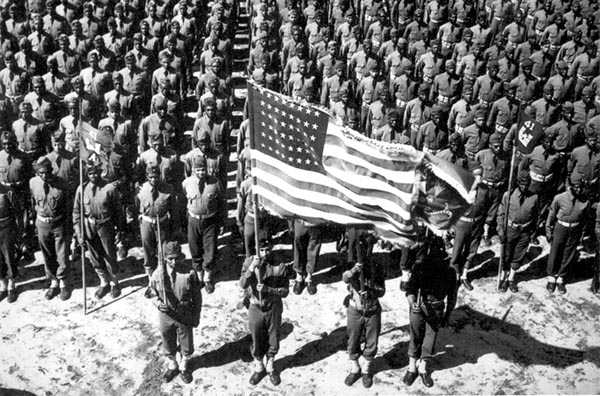Farm boys and sons of immigrants, they defeated Hitler, Tojo, and Mussolini. 400,000 of them never returned home. U.S. citizen soldiers known as G.I. Joe.
The Axis Powers thought that America lacked the will, moral character, and courage to wage war. Hitler believed Americans to be soft and hedonistic. The Japanese were assured that the United States would sue for peace after the attack on Pearl Harbor. The Italians felt that America was a culturally deprived society. The U.S. citizen soldiers, sailors, marines, and airmen proved that these assumptions were totally false. Through the efforts, devotion, and sacrifice of some 16 million men under arms, G.I.(Government Issue) Joe, a “regular guy”, was placed on the world stage as one of the greatest fighting men of history. With no pomp nor circumstance, he did his job so that he could go home. The U.S. citizen soldier was decisive in the winning of World War II.
Citizen Soldiers Prepare to Fight
In the aftermath of the attack on Pearl Harbor, America was ill prepared to launch a military counter strike against Japan. To worsen matters, Germany and Italy had also declared war on the United States. In conjunction with British Prime Minister Winston Churchill, President Roosevelt determined that “Germany First” was the way to conduct the strategic execution of the war, but how could he turn his citizen soldiers into fighting machines? First, the draft was begun again, filling the roster of a once peacetime military with millions of new recruits. Still reeling from the Great Depression, many other young men eager to find work, enlisted as a way to earn income. However, a peacetime military had to be forged into a well-oiled fighting force capable of delivering powerful blows to the enemies. The U.S. citizen soldier did have one weapon already intact, his willingness to exact revenge upon the enemy.
Before the beginning of the war, recruits had to train with boards on sawhorses designed to take the place of machine guns mounted on tripods, they fired at trucks with the word “Tank” painted on the side. This would no longer suffice. Federal funds were quickly allocated to purchase modern warfare equipment constantly being invented and experimented with for optimum firepower and effect. Weapons known as the Sherman Tank, B17 and B-25 Bombers, M-1 and Browning Semi-Automatic Rifles, Aircraft Carriers, to name just a few. The fighting man’s training, logistics, and professionalism were also addressed to become on a par if not exceeding that of the Axis soldier. Leaders were appointed to execute these changes, such as Douglas MacArthur, Chester Nimitz, Dwight Eisenhower and George Patton.
G.I. Joe, the U.S. Citizen Soldier Takes WW II to the Enemy
Citizen soldier means just that, a “regular guy”, not a career professional trained from birth to kill and make war. The names of battles such as D-Day, the Battle of the Bulge, Midway, Iwo Jima, and the Battle of the Coral Sea will live in the annals of military history forever. Aggressive invasions, aerial combat, hand to hand fighting, island hopping, ferocious house to house clean-up operations, pitched naval battles, and other war related terms were a common occurrance for the kids from New York City, Pueblo, Colorado, Oshkosh, Wisconsin, Atlanta, Georgia, and thousands of other “bergs” and “hamlets” throughout the country. The Axis soon learned of the heroism of an ordinary guy. More Congressional Medals of Honor were awarded in WW II than in any other conflict in U.S. military history except for the Civil War. Names like Audie Murphy and John Basilone are etched in war memorials alongside those of heroes from other times.
Nearly 400,000 American military personnel never made it back home from WW II. Their sacrifice and devotion to duty remains unquestioned. They came from every walk of life and every ethnic group imaginable. These heroes of WW II are among the bravest soldiers the world has ever seen or will ever see. What separates them from the rest is their total dedication to a common cause, their aura of humility, and their deep respect for their fellow man. The U.S. citizen soldier truly was a “regular guy”.
Source:
- Terkel, Studs. “The Good War”: An Oral History of World War Two. NY: Pantheon Books, a division of Random House, Inc., 1984.








